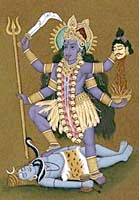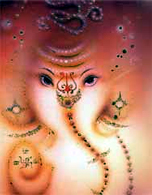First Day – Dhanteras Because there are many regions in India, there are many manifestations of the Diwali festival. The festival begins with Dhanteras, a day set aside to worship the goddess of prosperity, Shri Lakshmi. Lustrous Lakshmi is the consort of Vishnu, and her statue is found in every home. On this day, homes are thoroughly cleaned and windows are opened to welcome her blessing for the new year. In rural villages cattles are adorned and worshipped by farmers, and in the South of India, cows are offered special veneration as the incarnation of the goddess. Candles and lamps are lit to serve as as a greeting to Lakshmi. In Indian culture, wealth is not viewed as a corruptive power. Instead, a wealthy person is considered to have been rewarded for the good deeds of a past life. On this day, people exchange gifts and purchase new items for the house, as this is considered auspicious and ensures happiness and prosperity for the whole of the coming year. Business men (marwaldi) pray for prosperity on this day to Lakshmi, because it is believed to give the best results for the year ahead. Second Day – Kali Chaudas  On the second day Kali, the goddess of Strength, is worshipped. Delicacies are prepared from pounded partly-cooked rice (called Poha or Pauva) from the recent harvest. This custom is held in rural and in urban areas, especially in Western India. Diwali celebrates the end of the harvest season, known as the Kharif season when the fresh crop of rice is in, but also marks the beginning of the new season. This day (Kali Choudas) also focuses on abolishing laziness and evil. North Indians call it Narak Chaudas and will pray for the souls of departed loved ones. On the second day Kali, the goddess of Strength, is worshipped. Delicacies are prepared from pounded partly-cooked rice (called Poha or Pauva) from the recent harvest. This custom is held in rural and in urban areas, especially in Western India. Diwali celebrates the end of the harvest season, known as the Kharif season when the fresh crop of rice is in, but also marks the beginning of the new season. This day (Kali Choudas) also focuses on abolishing laziness and evil. North Indians call it Narak Chaudas and will pray for the souls of departed loved ones.Third Day – Diwali On the third and most important day (the last day of the year in the lunar calendar), lamps are lighted and shine brightly in every home. The lamp shining at the dark of the New Moon symbolizes knowledge and encourages reflection upon the purpose of each day in the festival. The goal is to remember the purpose throughout the coming year. Lakshmi Puja is performed on this day, awakening an appreciation of prosperity and a sense of responsibility towards it. Lakshmi, always depicted as a very beautiful woman, stands on a lotus. She has lotuses in various stages of bloom in her two hands and wears a lotus garland. Cascades of gold coins are usually shown flowing from her hands, suggesting that those who worship her gain wealth. She always wears gold-embroidered red clothes. Red symbolizes activity and the golden lining indicates prosperity. Lakshmi is the active energy of Vishnu, and also appears as Lakshmi-Narayan – Lakshmi accompanying Vishnu.  Lakshmi is the goddess of wealth and Ganesha is the Lord of Happiness. Lakshmi and Ganesha Puja is performed for prosperity, material abundance, and spiritual prosperity. The faithful believe that the worship of Lakshmi should not be neglected, lest poverty and suffering fall upon those who fail to remember her. This Puja is performed in the evening, as the Taurus ascendant and the Leo ascendant are considered the best for keeping the material benefits for the year. At this time, old business accounts are settled and new books are opened. The books are worshipped in a special ceremony and participants are encouraged to remove anger, hate, and jealousy from their lives. Lakshmi is the goddess of wealth and Ganesha is the Lord of Happiness. Lakshmi and Ganesha Puja is performed for prosperity, material abundance, and spiritual prosperity. The faithful believe that the worship of Lakshmi should not be neglected, lest poverty and suffering fall upon those who fail to remember her. This Puja is performed in the evening, as the Taurus ascendant and the Leo ascendant are considered the best for keeping the material benefits for the year. At this time, old business accounts are settled and new books are opened. The books are worshipped in a special ceremony and participants are encouraged to remove anger, hate, and jealousy from their lives.Fourth Day — Vishkarma The fourth day of Diwali falls on the first day of the lunar New Year and is called Vishkarma Day. Also known as Padwa or VarshaPratipada it marks the coronation of King Vikramaditya. Families celebrate the new year by dressing in new clothes, wearing jewellery and visiting family members and business colleagues bearing sweets, dried fruits and other gifts. This day is often used by manufacturers to pray for their equipment so that it works well and makes profit during the year ahead. In ancient times, the people of Gokul would celebrate a festival in honour of Lord Indra, worshipping him at the end of each monsoon season. However, in one particular year, the young Krishna halted the custom of offering prayers to Indra, who in a fit of anger poured down a deluge in order to destroy Gokul. Krishna saved Gokul by lifting up a mountain called Govardhan and holding it over the people as an umbrella. So, on this day, Goverdhan Puja is performed to commemorate this act of Sri Krishna. This day is also observed as Annakoot and prayers are offered in the temples. In Mathura and Nathadwara, the deities are bathed in milk, then dressed in shining attire, featuring ornaments of diamonds, pearls, rubies and other precious stones. Fifth Day On the final day (Balipratipada) of the festival, Bali, a powerful titanic figure in Indian Mythology, is recalled. Bali was the powerful demon-king of Paataala (the netherworld), who had boldly extended his kingdom over the earth as well. On the day, Sri Vishnnu, taking the form of Vaamana, a dwarfish Brahmin, approached Bali requesting a boon, comprising the amount of space equal to three of his steps. Bali, famed for his generosity, granted the boon. However, the "dwarf" then grew into a gigantic form and with one step covered the entire earth; with the second, he covered the sky, and then asked Bali where he should place his third step. Bali, left with no other choice, presented his own head. Sri Vishnu placed his foot on Bali's head, pushing him back down to the netherworld, the rightful territory of Bali's reign. However, Bali prayed that he might be permitted to visit the earth once a year. Then it was the turn of Vishnu to grant the boon. Thus, the focus of this day is to see the good in others, including enemies. It is particularly reverenced in Kerala. The second day of the bright fortnight (Shukla Paksh) of Kartika is also called Bhaiya-Duj. In the Vedic era, Lord Yama (Yamraj, the Lord of Death) visited his sister Yamuna (Yami), who marked the auspicious Tilak on his forehead. They ate and talked together, enjoying each other's company, exchanging special gifts as a token of their love for each other. Yamraj pronounced that anyone who receives the Tilak from his sister on this day is truly blessed. Since that time the custom has been for brothers to visit their sisters to celebrate Bhaiyaduj. The 'Teeka' is applied on the brother's forehead, but it is a day dedicated to sisters. Raksha Bandhan may be "brothers' day", but this is "sisters' day". Many Myths Surround Diwali Another myth traces the origins of the festival to the annual "inspection tours" of Lakshmi, the Hindu goddess of wealth and prosperity. The faithful believe that on this day Lakshmi goes around visiting her devotees and sets up residence in the house she finds best spruced up and most hospitable. Diwali is an occasion for spring cleaning, painting the walls, decorating the floor with attractive designs wrought in coloured powder, or paste made with rice. The slaying by Krishna of the demon lord Narakasura after a long march from Dvaraka (Gujarat) in the West to Pragjyotishapura (Assam) in the East and the overcoming by Rama of the demon king Ravana in Lanka in the South and his triumphant march back to Ayodhya in the North is held to represent the unification of the four corners of the land of Bharata Varsha (North, South, East and West) through the triumph of good over evil. This is said to be the source of the underlying joy that surfaces at this festival. The chief ritual traditionally associated with Diwali is gambling. Friends get together to indulge in games of chance, dice or cards. The "addicts" seek legitimacy for their pastime by referring to the celestial game of dice played by the great lord Shiva with his companion Parvati - a scene superbly sculpted at Kailash temple, Ellora. Others rationalise that this is just to remind oneself of the fickleness of lady luck and to inculcate a sense of balance in our pursuit of material success. At Diwali, the children can be seen bursting firecrackers and lighting candles or earthen lamps. This is a time of exchanging sweets with neighbours and friends. Puffed rice and sugar candy are the favourites. |
Dear Visiters...
DeogharLive :-[Anything / Anywhere about Deoghar] is a Blogs for Deoghar City, from
Where you can Get :-Deoghar News / Deoghar Information / Deoghar Lifestyle / Deoghar temple News / Deoghar Health & Wellness / Entertainment / Deoghar Educational News / Music / Events in Deoghar / Deoghar Photographs / Taveling guidance & Much More about Deoghar City……..
DeogharLive :- Our Main Motive to MakeNatural/Cultural/Educational/Easiest Lifestyle for DEOGHAR People & Near about city/also for Travelers by this Blogs. We are a Leading
Company in Online Advt. & Digital Marketing Named byADSCLINIC.IN *
About Deoghar in Briefs :- Deoghar is a God’s Home of Lord SHIVA(Dev+Ghar),Where temple of Lord Shiva Which is Famous all India&World. you can enjoy your peaceful life,by natural,cultural, beautiful Place you can See on Earth……
Visiting Place in Deoghar :- Deoghar temple, Tapovann, Trikuty Parwat, Baski Nath, Arogaya Bhawan Jashidih, Nandan Pahar, Tower chowk, Bombay Bazaar, Shiv Ganga, Naulakha Mandir, Ram KrishanMission Vidyapeeth, Satsanga Ashram, Rikhia Ashram,Central Plaza Mall (Big Bazaar), Biit Mishra College Jashidih & More….
Deoghar City:- Deoghar is a fast Growing City in Jharkhand,There are three Railway Stations&Airport is also Going to be Launched Soon,Best Educational Institutes/Schools/Colleges&IT Companies,Banking&Finance,Jobs,Cental Plaza Mall(Big Bazaar) & more for Lifestyle n Carrers n Job&Much More……..
Thanks & Regards...
Team of Deoghar Live
Sunday, October 23, 2011
dewali in jharkhand,india,deoghar,happy dewali , dewali offer
Thanks for your visit. please visit again













No comments:
Post a Comment